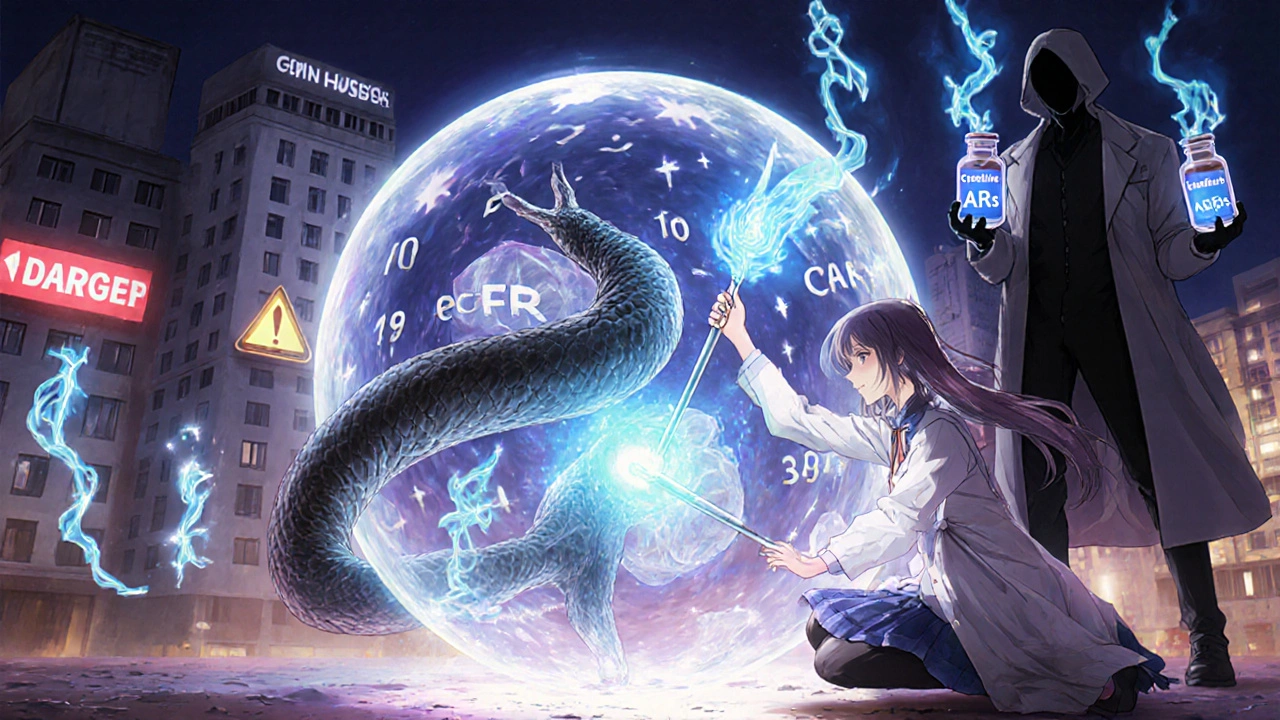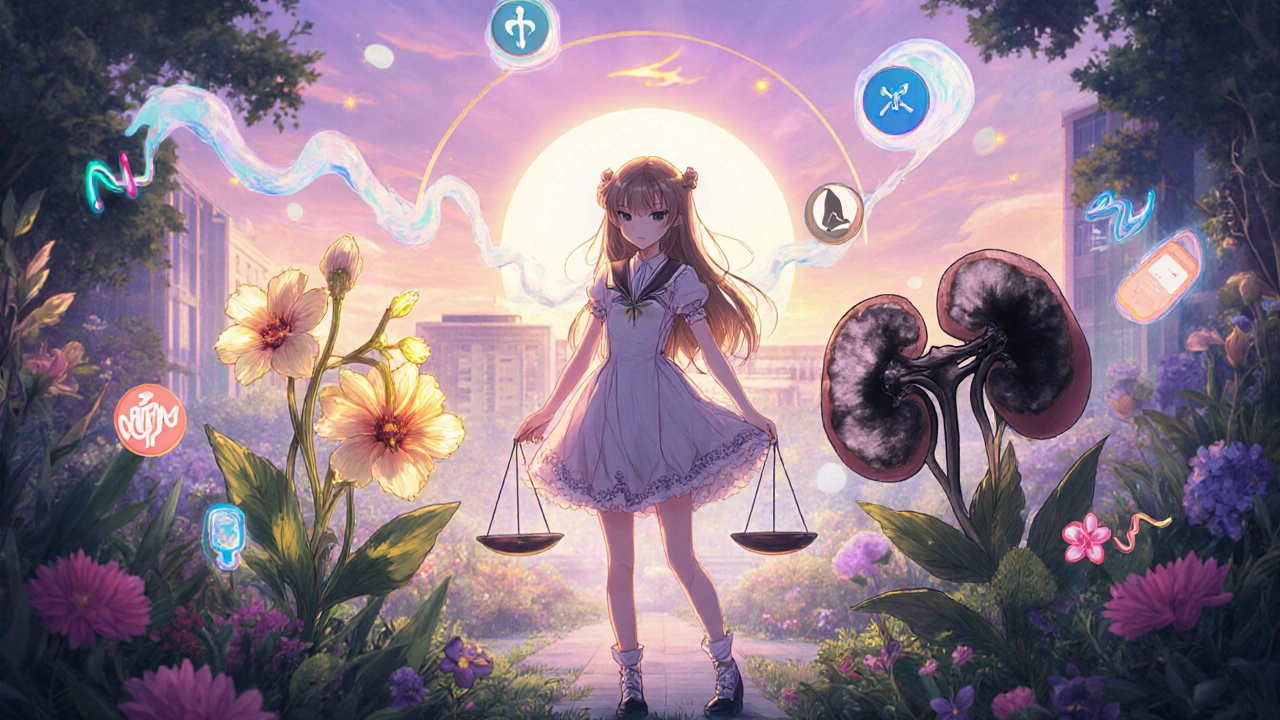When your kidneys don't get enough blood flow, your body tries to compensate. It releases renin, which triggers a chain reaction leading to angiotensin II - a powerful chemical that squeezes the tiny blood vessels leaving your kidneys. This keeps your filters working, even when blood pressure is low. But if you take an ACE inhibitor, you shut down this lifeline. And for people with narrowed renal arteries, that can mean sudden, dangerous kidney failure.
How ACE Inhibitors Work - and Why They're Dangerous in Stenosis
ACE inhibitors like lisinopril, enalapril, and ramipril are common blood pressure drugs. They block the enzyme that turns angiotensin I into angiotensin II. That’s good for most people: less constriction, lower blood pressure, less strain on the heart. But in someone with renal artery stenosis, this same mechanism becomes a threat.
Renal artery stenosis means one or both arteries feeding your kidneys are narrowed - often by plaque buildup. When blood flow drops, the kidney thinks it’s in shock. It pumps out renin. That leads to angiotensin II, which tightens the efferent arteriole - the exit pipe of the kidney’s filtering unit. This keeps pressure high inside the glomerulus, so filtration doesn’t collapse.
Now, give that person an ACE inhibitor. Angiotensin II vanishes. The efferent arteriole relaxes. Pressure inside the glomerulus drops by 25-30%. Filtration slows. Creatinine rises. Within days, kidney function plummets.
This isn’t theoretical. In 1984, researchers published a landmark study in the New England Journal of Medicine showing 12 out of 15 patients with bilateral renal artery stenosis developed acute kidney failure after taking captopril. That finding hasn’t changed in 40 years.
Bilateral vs. Unilateral: The Critical Difference
Not all renal artery stenosis is the same. The danger is real only when both kidneys are affected, or when you have one kidney and it’s narrowed.
If you have one healthy kidney and one narrowed one, your good kidney can compensate. It handles the workload. ACE inhibitors can be used cautiously here - but only under close monitoring.
But if both arteries are narrowed? There’s no backup. The kidneys rely entirely on angiotensin II to keep filtering. Remove it, and filtration crashes. Studies show patients with bilateral stenosis who start ACE inhibitors see their eGFR drop by nearly 19 mL/min/1.73m² on average - a massive, rapid decline. In contrast, those with unilateral stenosis and a healthy kidney show almost no change.
The American Heart Association and KDIGO guidelines are clear: ACE inhibitors are contraindicated in bilateral renal artery stenosis or stenosis in a solitary kidney. This isn’t a gray area. It’s a hard stop.
What Happens When You Ignore the Warning
Many patients don’t know they have renal artery stenosis until it’s too late. It often has no symptoms. A doctor might hear a bruit - a whooshing sound over the abdomen - but that’s rare. More often, the first clue is a sudden spike in creatinine after starting a blood pressure pill.
One 2018 study tracked 1,247 people starting ACE inhibitors. Among those with undiagnosed bilateral stenosis, nearly 19% developed acute kidney injury - defined as a 30% or greater rise in creatinine. Only 2.3% of those without stenosis had that reaction.
That rise usually shows up within 7 to 10 days. That’s why guidelines say: check kidney function before starting, and again 10 days after. If creatinine jumps more than 30%, stop the drug immediately. Most of the time, kidney function returns to normal within days of stopping.
But if you wait too long - past 72 hours - the damage can become permanent. Cells die. Scar tissue forms. The kidneys lose their ability to recover.

ARBs Are Not a Safe Alternative
Some doctors think, "If ACE inhibitors are risky, maybe ARBs like losartan or valsartan are safer." They’re not.
ARBs block the same final pathway - angiotensin II receptors. They don’t stop production, but they stop the effect. The result? Same drop in glomerular pressure. Same risk of acute kidney injury.
The 2019 KDIGO guidelines explicitly list ARBs as contraindicated in the same situations as ACE inhibitors. Using an ARB instead doesn’t fix the problem - it just delays the crash.
There’s no magic substitute here. If you have bilateral stenosis, you need a different strategy: calcium channel blockers, diuretics, or beta-blockers - drugs that don’t depend on the renin-angiotensin system to lower blood pressure.
Who Should Be Screened Before Starting ACE Inhibitors?
Not everyone needs a scan before taking an ACE inhibitor. But some people are at high risk:
- People over 65 with new or worsening high blood pressure
- Those with sudden kidney dysfunction without obvious cause
- Patients with a history of atherosclerosis - especially if they’ve had heart attacks, strokes, or peripheral artery disease
- Anyone with an abdominal bruit
- People with unexplained kidney failure after starting an ACE inhibitor
For these patients, a renal artery duplex ultrasound is the first-line test. It’s non-invasive, widely available, and detects significant stenosis with 86% sensitivity and 92% specificity.
According to European guidelines, about 7% of hypertensive patients with kidney problems actually have renal artery stenosis. That’s not rare. It’s common enough that skipping screening is a mistake.

Why Do Doctors Still Prescribe ACE Inhibitors in High-Risk Patients?
Despite clear guidelines, a 2020 study found that over 22% of patients with known bilateral renal artery stenosis were still being prescribed ACE inhibitors in primary care settings.
Why? Three reasons:
- Many doctors don’t know the patient has stenosis - it’s often undiagnosed.
- Others assume the patient’s kidney function is "stable enough" to risk it.
- Some think the benefit of blood pressure control outweighs the risk.
But the data doesn’t support that. The risk of sudden kidney failure is real. The benefit - lowering blood pressure - can be achieved safely with other drugs. There’s no justification for gambling with kidney function.
What to Do If You’re on an ACE Inhibitor
If you’re taking an ACE inhibitor and have any of these risk factors:
- High blood pressure that’s hard to control
- History of vascular disease
- Unexplained rise in creatinine
- Abdominal bruit
Ask your doctor: "Could I have renal artery stenosis?" Request a duplex ultrasound before your next refill.
If you’ve just started an ACE inhibitor, make sure your creatinine was checked before you began - and again 10 days later. If it rose more than 30%, don’t wait. Call your doctor. Don’t assume it’s "just a side effect."
And if you’ve been told you have renal artery stenosis - especially bilateral - don’t take ACE inhibitors or ARBs unless a specialist says it’s safe. And even then, monitor closely.
Bottom Line: This Contraindication Hasn’t Changed in 40 Years
ACE inhibitors are powerful tools. But they’re not safe for everyone. In renal artery stenosis, they don’t just cause side effects - they can trigger irreversible kidney damage.
The science is solid. The guidelines are clear. The warning has been around since the 1980s. And yet, too many patients still get caught in the trap.
If you’re prescribed an ACE inhibitor and have risk factors for renal artery stenosis, speak up. Ask for a simple ultrasound. Get your creatinine checked before and after starting. Don’t let a routine blood pressure pill become the cause of kidney failure.
This isn’t about avoiding medication. It’s about choosing the right one - safely.

 Pharmacology
Pharmacology
Sherri Naslund
November 19, 2025 AT 05:55Ashley Miller
November 19, 2025 AT 14:26Martin Rodrigue
November 20, 2025 AT 14:33Hannah Machiorlete
November 21, 2025 AT 04:06